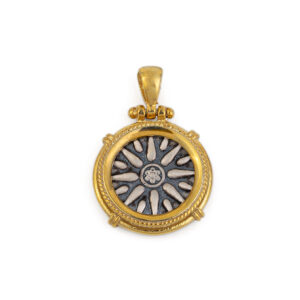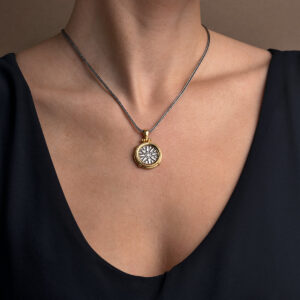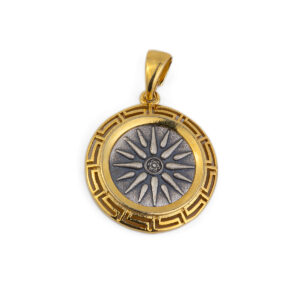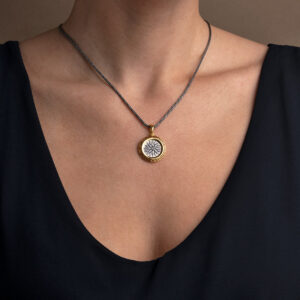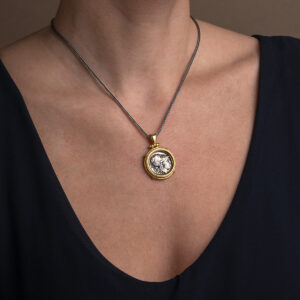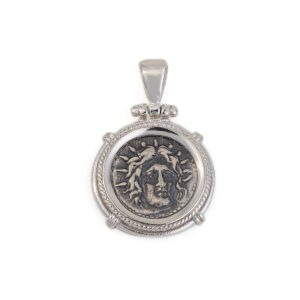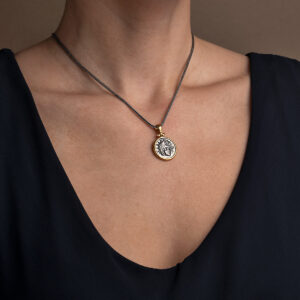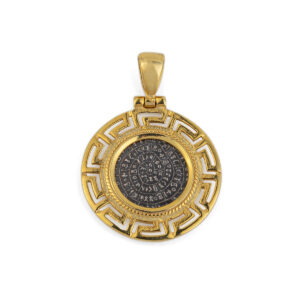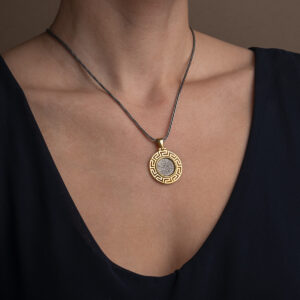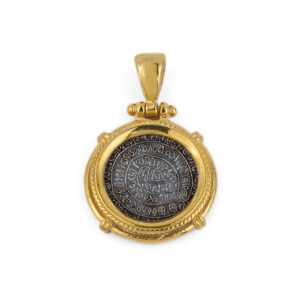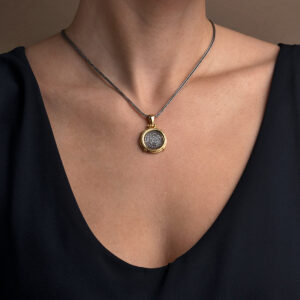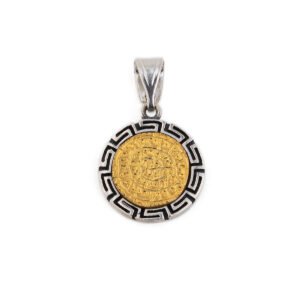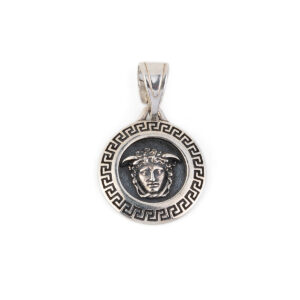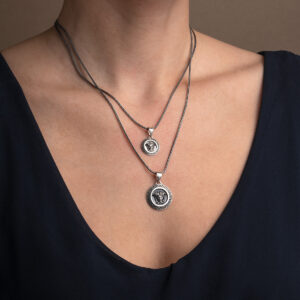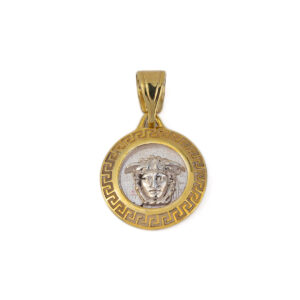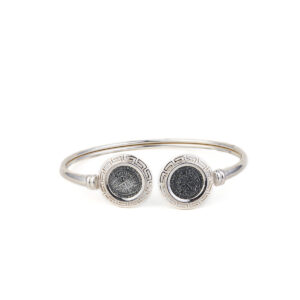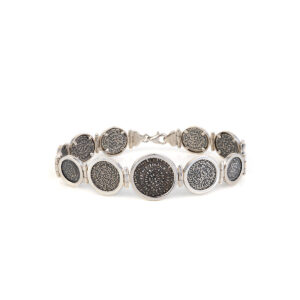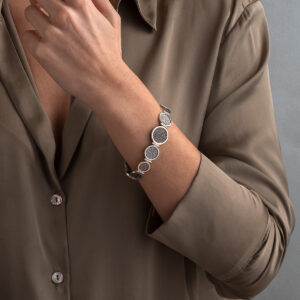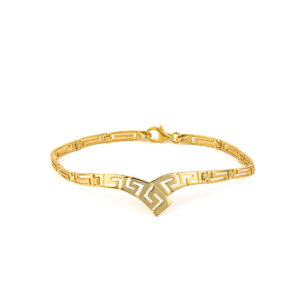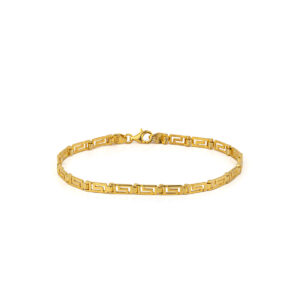Vergina Sun Pendant – Sterling Silver and Gold Plated
This pendant illustrates the Vergina symbol.
Made of 925 sterling silver and gold plated.
Handmade in Greece. Explore Heritage Collection
History
The Vergina Sun also known as the “Star of Vergina”, or “Macedonian Star” is a rayed solar symbol appearing in ancient Greek art. The Vergina Sun proper has sixteen triangular rays. The name “Vergina Sun” became widely used after the archaeological excavations in and around the small town of Vergina, in northern Greece, during the late 1970s. In older references, the name “Argead Star” or “Star of the Argeadai” is used for the Sun as the royal symbol of the dynasty of Macedon. There it was depicted on a golden larnax found in a 4th-century BC royal tomb belonging to either Philip II or Philip III of Macedon, the father and half-brother of Alexander the Great, respectively.
Greek Key Vergina Sun Pendant – Sterling Silver and Gold Plated
This pendant illustrates the Vergina symbol.
Made of 925 sterling silver and gold plated.
Handmade in Greece. Explore Heritage Collection
History
The Vergina Sun also known as the “Star of Vergina”, or “Macedonian Star” is a rayed solar symbol appearing in ancient Greek art. The Vergina Sun proper has sixteen triangular rays. The name “Vergina Sun” became widely used after the archaeological excavations in and around the small town of Vergina, in northern Greece, during the late 1970s. In older references, the name “Argead Star” or “Star of the Argeadai” is used for the Sun as the royal symbol of the dynasty of Macedon. There it was depicted on a golden larnax found in a 4th-century BC royal tomb belonging to either Philip II or Philip III of Macedon, the father and half-brother of Alexander the Great, respectively.
Athena – Stater of Corinth Pendant – 925 Sterling Silver Gold Plated
Made of 925° sterling silver and gold plated.
Handmade item. Explore Coins Collection
This Ancient Greek coin represents Athena Chalinitis on the front side and the inscription “ΑΛΕΞΑΝΔΡΟΥ” on the backside.
Athena – Stater of Corinth
This silver stater of Corinth depicts the head of Athena Chalinitis.
Helios Sun Pendant – Sterling Silver
Made of 925° sterling silver.
Handmade item. Explore Coins Collection
Handmade pendant, inspired by an ancient Greek tetradrachm coin of Rhodes.
This Ancient Greek coin illustrates Helios Sun God on the one side and the flower rhodon (rose), a symbol of Rhodes on the other. The inscription reads : “RHODION” in Greek fonts.
Helios, in Greek mythology, is the god and personification of the Sun, often depicted in art with a radiant crown and driving a horse-drawn chariot through the sky.
Helios Sun Pendant – 925 Sterling Silver Gold Plated
Made of 925° sterling silver and gold plated.
Handmade item. Explore Coins Collection
Handmade pendant, inspired by an ancient Greek tetradrachm coin of Rhodes.
This Ancient Greek coin illustrates Helios Sun God on the one side and the flower rhodon (rose), a symbol of Rhodes on the other. The inscription reads : “RHODION” in Greek fonts.
Helios, in Greek mythology, is the god and personification of the Sun, often depicted in art with a radiant crown and driving a horse-drawn chariot through the sky.
Greek Key Phaistos Disc Pendant – Sterling Silver and Gold Plated
Made of 925° sterling silver and gold plated.
Handmade item. Explore Phaistos Disc Collection
The Phaistos Disc is a disk of fired clay from the Minoan palace of Phaistos on the island of Crete. Now, the island of Crete is part of modern Greece. The disc was discovered in 1908 by the Italian archaeologist Luigi Pernier in the Minoan palace site of Phaistos. While it is not clear that it is a script, most attempted decipherments assume that it is; most additionally assume a syllabary, others an alphabet or logography or a calendar. The Malia honeybee pendant was discovered at Chryssolakkos, of the Minoan Palace of Malia on the island of Crete, and is thought to date to c.1800 BC. The named Chryssolakkos means the “pit of gold” because of the precious objects that the farmers used to find there. The Minoan Palace is situated 3 km east of Malia town and is the third most significant known Minoan Palace after Knossos and Phaistos. This pendant is in the shape of two bees, or wasps, storing away a drop of honey in a comb and is one of the most famous exhibits in the Heraklion Museum.
Phaistos Disc Pendant – Sterling Silver and Gold Plated
Made of 925° sterling silver and gold plated.
Handmade item. Explore Phaistos Disc Collection
The Phaistos Disc is a disk of fired clay from the Minoan palace of Phaistos on the island of Crete. Now, the island of Crete is part of modern Greece. The disc was discovered in 1908 by the Italian archaeologist Luigi Pernier in the Minoan palace site of Phaistos. While it is not clear that it is a script, most attempted decipherments assume that it is; most additionally assume a syllabary, others an alphabet or logography or a calendar. The Malia honeybee pendant was discovered at Chryssolakkos, of the Minoan Palace of Malia on the island of Crete, and is thought to date to c.1800 BC. The named Chryssolakkos means the “pit of gold” because of the precious objects that the farmers used to find there. The Minoan Palace is situated 3 km east of Malia town and is the third most significant known Minoan Palace after Knossos and Phaistos. This pendant is in the shape of two bees, or wasps, storing away a drop of honey in a comb and is one of the most famous exhibits in the Heraklion Museum.
Phaistos Disc and Minoan Bees Pendant – 925 Sterling Silver and Gold Plated
Made of 925° sterling silver and gold plated.
Handmade item. Explore Phaistos Disc Collection
The Phaistos Disc is a disk of fired clay from the Minoan palace of Phaistos on the island of Crete. Now, the island of Crete is part of modern Greece. The disc was discovered in 1908 by the Italian archaeologist Luigi Pernier in the Minoan palace site of Phaistos. While it is not clear that it is a script, most attempted decipherments assume that it is; most additionally assume a syllabary, others an alphabet or logography or a calendar. The Malia honeybee pendant was discovered at Chryssolakkos, of the Minoan Palace of Malia on the island of Crete, and is thought to date to c.1800 BC. The named Chryssolakkos means the “pit of gold” because of the precious objects that the farmers used to find there. The Minoan Palace is situated 3 km east of Malia town and is the third most significant known Minoan Palace after Knossos and Phaistos. This pendant is in the shape of two bees, or wasps, storing away a drop of honey in a comb and is one of the most famous exhibits in the Heraklion Museum.
Medusa Pendant – Gold Plated Pendant
Made of 925° sterling silver and gold plated.
Handmade item. Explore Heritage Collection
Medusa, in Greek mythology, the most famous of the monster figures known as Gorgons, is generally described as a winged female with living venomous snakes in place of hair; unlike the Gorgons, she was sometimes represented as very beautiful. According to Hesiod and Aeschylus, she lived and died on an island named Sarpedon, somewhere near Cisthene. Medusa was beheaded by the hero Perseus, who thereafter used her head, which retained its ability to turn onlookers to stone, as a weapon until he gave it to the goddess Athena to place on her shield. according to another account; Perseus buried it in the marketplace of Argos. The Labyrinth in ancient Greece was an elaborate, confusing structure designed and built by the legendary artificer Daedalus for King Minos of Crete at Knossos. Its function was to hold the Minotaur. the Minotaur is a mythical creature portrayed in Classical times with the head of a bull and the body of a man. The Minotaur was eventually killed by the Athenian hero Theseus.
Medusa Pendant – Sterling Silver
Made of 925° sterling silver.
Handmade item. Explore Heritage Collection
Medusa, in Greek mythology, the most famous of the monster figures known as Gorgons, is generally described as a winged female with living venomous snakes in place of hair; unlike the Gorgons, she was sometimes represented as very beautiful. According to Hesiod and Aeschylus, she lived and died on an island named Sarpedon, somewhere near Cisthene. Medusa was beheaded by the hero Perseus, who thereafter used her head, which retained its ability to turn onlookers to stone, as a weapon until he gave it to the goddess Athena to place on her shield. according to another account; Perseus buried it in the marketplace of Argos. The Labyrinth in ancient Greece was an elaborate, confusing structure designed and built by the legendary artificer Daedalus for King Minos of Crete at Knossos. Its function was to hold the Minotaur. the Minotaur is a mythical creature portrayed in Classical times with the head of a bull and the body of a man. The Minotaur was eventually killed by the Athenian hero Theseus.
Medusa Pendant – 925 Sterling Silver
Made of 925° sterling silver.
Handmade item. Explore Heritage Collection
Medusa, in Greek mythology, the most famous of the monster figures known as Gorgons, is generally described as a winged female with living venomous snakes in place of hair; unlike the Gorgons, she was sometimes represented as very beautiful. According to Hesiod and Aeschylus, she lived and died on an island named Sarpedon, somewhere near Cisthene. Medusa was beheaded by the hero Perseus, who thereafter used her head, which retained its ability to turn onlookers to stone, as a weapon until he gave it to the goddess Athena to place on her shield. according to another account; Perseus buried it in the marketplace of Argos. The Labyrinth in ancient Greece was an elaborate, confusing structure designed and built by the legendary artificer Daedalus for King Minos of Crete at Knossos. Its function was to hold the Minotaur. the Minotaur is a mythical creature portrayed in Classical times with the head of a bull and the body of a man. The Minotaur was eventually killed by the Athenian hero Theseus.
Medusa Pendant – 925 Sterling Silver and Gold Plated Pendant
Made of 925° sterling silver and gold plated.
Handmade item. Explore Heritage Collection
Medusa, in Greek mythology, the most famous of the monster figures known as Gorgons, is generally described as a winged female with living venomous snakes in place of hair; unlike the Gorgons, she was sometimes represented as very beautiful. According to Hesiod and Aeschylus, she lived and died on an island named Sarpedon, somewhere near Cisthene. Medusa was beheaded by the hero Perseus, who thereafter used her head, which retained its ability to turn onlookers to stone, as a weapon until he gave it to the goddess Athena to place on her shield. according to another account; Perseus buried it in the marketplace of Argos. The Labyrinth in ancient Greece was an elaborate, confusing structure designed and built by the legendary artificer Daedalus for King Minos of Crete at Knossos. Its function was to hold the Minotaur. the Minotaur is a mythical creature portrayed in Classical times with the head of a bull and the body of a man. The Minotaur was eventually killed by the Athenian hero Theseus.
Phaistos Disc Cuff Bracelet – 925 Sterling Silver
A bracelet inspired by the ancient disk found in Phaistos.
Made of 925⁰ sterling silver.
Handmade in Greece.
Explore Phaistos Disc Collection
History
The Phaistos Disc is a disk of fired clay from the Minoan palace of Phaistos on the island of Crete. Now, the island of Crete is part of modern Greece. The disc was discovered in 1908 by the Italian archaeologist Luigi Pernier in the Minoan palace site of Phaistos. While it is not clear that it is a script, most attempted decipherments assume that it is; most additionally assume a syllabary, others an alphabet or logography or a calendar.
Phaistos Disc Link Bracelet – Sterling Silver
A bracelet inspired by the ancient disk found in Phaistos.
Made of 925⁰ sterling silver.
Handmade in Greece.
Explore Phaistos Disc Collection
History
The Phaistos Disc is a disk of fired clay from the Minoan palace of Phaistos on the island of Crete. Now, the island of Crete is part of modern Greece. The disc was discovered in 1908 by the Italian archaeologist Luigi Pernier in the Minoan palace site of Phaistos. While it is not clear that it is a script, most attempted decipherments assume that it is; most additionally assume a syllabary, others an alphabet or logography or a calendar.
Greek Meander Link Bracelet – 925 Sterling Silver Gold Plated
Bracelet inspired by the Greek Key meander symbol.
Made of sterling silver 925° and gold plated.
Handmade in Greece.
Explore Meandros Collection
History
Meandros design is a decorative border constructed from a continuous line, shaped into a repeated motif. Such a design is also called the Greek fret or Greek key design, although these are modern designations. On the one hand, the name “meander” recalls the twisting and turning path of the Meander River in Asia Minor, and on the other hand, as Karl Kerenyi pointed out, “the meander is the figure of a labyrinth in linear form” the meaning is that there is no beginning and no end in some cases so it becomes the symbol of long life and eternity.
Greek Key Link Bracelet – 925 Sterling Silver Gold Plated
Bracelet inspired by the Greek Key meander symbol.
Made of sterling silver 925° and gold plated.
Handmade in Greece.
Explore Meandros Collection
History
Meandros design is a decorative border constructed from a continuous line, shaped into a repeated motif. Such a design is also called the Greek fret or Greek key design, although these are modern designations. On the one hand, the name “meander” recalls the twisting and turning path of the Meander River in Asia Minor, and on the other hand, as Karl Kerenyi pointed out, “the meander is the figure of a labyrinth in linear form” the meaning is that there is no beginning and no end in some cases so it becomes the symbol of long life and eternity.

